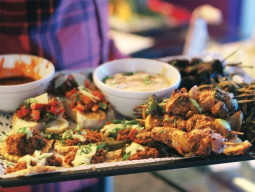
The month-long fasts of Ramazan will end on Friday night in North America, when the new month of Shawwal arrives at moonrise, according to the Islamic calendar.
The celebration of Eidul Fitr, a holiday dedicated to feasting, begins the next day across the Muslim world. In Astoria, Queens, young Muslim-Americans from diverse backgrounds will converge on halal burger joints and kebab palaces.
“The parents will stay home and eat biryani,” said Zayn Hassan, a Pakistani-American student who was buying macarons to break the daily fast at Shawarmania in Astoria last month. “For us, cheeseburgers and chicken wings.”
Read: Shopping frenzy: Markets crowded with shoppers ahead of Eid
Sumayya Usmani, who writes the food blog My Tamarind Kitchen, moved from Pakistan to Britain in 2007, and her memories of traditional celebrations are vibrant and clear.
“On Eid, you are encouraged to eat all the things that are too rich, too sweet, too creamy for a normal day,” she said. In Karachi, that meant fluffy pineapple layer cake; plump fried-meat-filled samosas; and seviyan (toasted thin wheat noodles, also called semiyan, sev or semiya) topped with khoya, a creamy mass of cooked and caramelized milk. “The whole day is dedicated to rejoicing in having food on the table,” she said.
In the Middle East, Eid is often welcomed with stuffed pastries like kahk and mahmoul; in Southeast Asia, with ketupat, rice steamed in bundles of woven palm fronds; in South Asia, with rich meat dishes and supersweet desserts.
Ms. Usmani was taught that fasting is meant to remind the community of those who go hungry every day; making gifts and donations of food are part of the holiday’s rituals. Starting at about age 10, she said, children fast until noon, then gradually work up to the sunrise-to-sunset fast that is expected of all Muslim adults. “It takes a long time to learn to avoid being distracted by hunger,” she said. “But you do get used to it. And it makes Eid that much more festive.”
Desserts made with seviyan are popular all over South Asia. Toasting the noodles in butter until they smell nutty is the key to the dish’s depth; the next layer of flavor comes from cooking them in spice-scented milk or syrup; finally, nuts and dried fruit provide crunch and chew.
Read: 5 easy-to-make drinks to serve on Eid
Ms. Usmani’s version, adapted from her maternal grandmother’s signature recipe, is less overwhelming than the traditional sweets of South Asia. “She actually used one part seviyan to 16 parts sugar,” she said. “I think a one-to-one ratio is ideal.”
This article originally appeared on New York Times


































































COMMENTS
Comments are moderated and generally will be posted if they are on-topic and not abusive.
For more information, please see our Comments FAQ